An imposing drag queen in a leopard-print top flaunts her décolleté after the show. She totters through the glitter, tinsel, and pills scattered on the floor and walks over to a massive tropical plant, from which she fishes out a lighter, lights a cigarette, and breaks out in a terrible cough, exhaling glitter from deep in her throat. In the background, a slideshow displays oversized portrait figures wearing fanciful masks made of various trashy but glamorous materials, partly referencing protest cultures and queer subcultures since the 1970s.
A curious communication between doubled images takes place, since the drag queen on stage as well as a punk figure now appearing there are the same figures portrayed in the projected slides. The punk appears in a cut denim vest, cheeky samurai-style hair tuft, and colorful makeup emphasizing the dark glitter eye shadow. Positioned in front of the photographs, curious doublings and overlappings are created as the punk recites a list of all the toxic substances that come to mind. Her tone of voice remains undecided, somewhere between condemnation and ovation, and the list seems to induce her to start cleaning the floor. Yet this transforms into a dance with a broom and a vacuum cleaner, where the whirling silver tinsel, the body in movement, the masks gazing from behind the figures onstage, and the tropical plants together form a queer assemblage—one that carries with it histories of intoxication. Destructive pleasures and pleasurable destructiveness are bound up with desiring relations.
In a further shift, the address to the audience returns from the punk to the drag queen, who, posing on a comfy chair, enters into a self-reflective monologue that turns into a complaint, then an accusatory dialogue that reveals the formerly intimate after-show scenario to have been a film production. A fight with the media apparatus over its inherent power relations, and the doubts and desires for recognition and control on the side of the protagonist, expose conditions of queer sociality and its limits.
And then it starts all over again with a cigarette smoked out of exhaustion on a toxic glimmering stage.
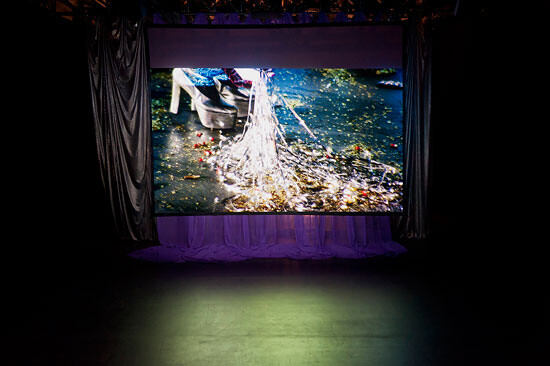

Toxic (voice 1)
The film Toxic (2012) shows two protagonists in an undetermined time: a glamorous punk figure (Ginger Brooks Takahashi) and an imposing drag queen (Werner Hirsch), both of unclear gender and origin.1 They linger in an environment of glossy remains and a forest of toxic plants. The background images of transformed ethnographic and police photographs are projected on a screen in a rhythm set by the clicks of a camera. The punk’s speech and performance reference early feminist artworks such as Yvonne Rainer’s dance piece Inner Appearances and Mierle Laderman Ukele’s grooming of art institutions.2 The drag queen reenacts an interview with Jean Genet from the 1980s and blames the filmmakers for exposing her to the police-like scenario of being filmed. The camera turns and depicts the space-off, the space outside the frame, thus revealing the apparatus of film production and the personalization of its regime.
When Pauline Boudry and I started our research about the discourse on and employment of “toxicity,” we initially focused on the so-called mug shot. The mug shot—invented in the late nineteenth century—is a way to photograph a human with two cropped and paired sights, one frontal, the other from profile. It was used by various state and scientific institutions, such as the police or anthropology, to identify “characters,” which meant, to install social hierarchies and to legitimize privileges. The photographers and viewers acquired normalcy and privilege through marking the photographed as criminals, sex workers, homosexuals, black people, and people from the colonies. This history fundamentally troubles the usage of the visual and photography in contemporary art:3 How can we produce, in the frame of this violent history of visualization, representations of bodies that rupture and queer this legacy of violence? We started from the assumption that it could be useful to see not only substances—chemicals or parts of plants, for instance—as toxic but the film apparatus as well, its history since the nineteenth century and its social effects, but also the way we continue to work in it. Furthermore, the film apparatus uses chemicals for transmuting light, which is reflected by objects and captured in images that cannot be separated from their means of production.4 Moreover, these images have been used to poison. However, neither the effects nor the critical dosage is predictable.
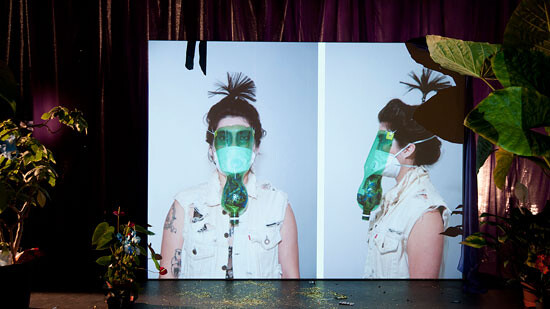

Our shooting took place in Paris, where the film was supposed to premiere as part of the Paris Trienniale, which was entitled “Intense Proximity” and dealt with French anthropological and colonial history. Accordingly, the Paris World’s Fairs of the late nineteenth and early twentieth centuries were ghosts that accompanied our search. Pauline and I discussed W.E.B. du Bois’s series of 363 photographs called Types of American Negroes, Georgia, U.S.A, which were his contribution to the American Negro Exhibit at the 1900 World’s Fair in Paris and won him a gold medal. While largely making use of the mug shot, Du Bois’s photographs still might be seen as toxic to the legacy of racist taxonomy and eugenics, which were so overwhelmingly present at the World’s Fair. Du Bois’s photographs utilize familiar elements: shots from the front and from profile, no full names, no explanatory captions which might point in the direction of critique, social antagonism, or antiracism. But the doses, effects, and affectivities are different: instead of producing “white” viewers and inviting them to learn to identify the individuals represented, to scrutinize the bodily markers, the gaze here seems to be more complicated. The light is softer, the eyes of the photographed are allowed to wander and look off camera, they sometimes grin, they look as if in complicity, or it seems they almost can’t hold back from laughing.
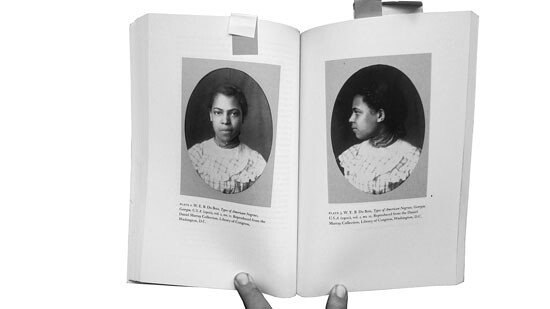



Time and again, quite diverse body markers refuse to function as signs of racial difference; some of the portraits display middle-class clothes and decorative elements such as Victorian chairs, books, and lace curtains. Shawn Michelle Smith describes how the careful weighing of elements makes use of toxic effects: “By ‘signifying’ on the form of the criminal as well as the scientific mug shot, Du Bois’s photographs suggest that for some (white) viewers, the middle-class portrait of an African-American was equivalent to the mug shot of a criminal … It is precisely this transformation of the black image in the eyes of white beholders (a transformation of the black image into a criminal mug shot) that Du Bois’s Georgia Negro portraits unmark.”5 It is striking that Du Bois successfully showed this presentation amidst the World’s Fair of 1900, which is known for its specifically racist “human zoos.”
We were also looking for images of homosexuals and transvestites, a search that turned out to be more difficult. With the support of our friend and colleague Virginie Bobin we finally found portraits of homosexuals and transvestites at the Paris police archive. These so-called pederastes were caught and photographed by the police in the 1870s. Their photographs were taken at a time when the state institutions had not yet developed their own visualizing methods and apparatus. They obviously took the apprehended homosexuals to commercial photography studios and had them photographed in a bourgeois setting, with the same poses of pride and peacocky self-presentation that had been developed as means of recognition by the establishment. This inspired the thesis that we experimented with during the shooting of Toxic: Even if the cinematic apparatus tries to allow for unmediated objectivity and knowledge about “stranger danger,”6 it might—as dirty and uncanny by-products—also produce ec/static bodies and queer connections. As a first step we produced a series of photographs–assemblages of historic mug shots and a range of elements from protest movements and queer subculture. These assemblages became the backdrops of our film. These assemblages became the backdrops of our film.
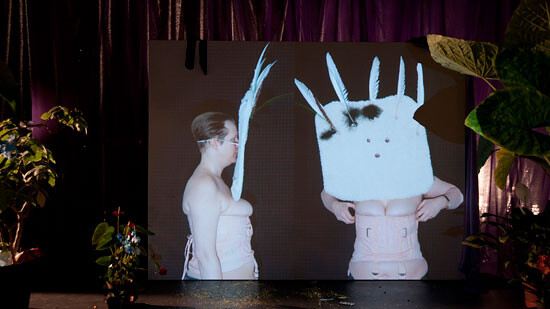

Toxicity (voices 1 & 2)
The discourse on toxicity alludes to many different fields of politics, especially those touching on the body, such as HIV/AIDS and the history of AIDS movements, illness in general, and the engagement of patient movements (e.g., the SPK, or “Socialist Patient Collective”), drugs, and the question how they intervene into the pace of capitalism, bodies in transition and the freeing of hormones from medicalized practices. Furthermore, toxicity and media have an intimate relationship. Yet they are by no means monogamous, but rather develop multiple and dynamic connections that could be called “toxic assemblages.” Mug shots intoxicate bodies that are captured by the criminalizing or pathologizing gaze. Subjectivities, insinuated as toxins of the social body, inhabit fantasies and travel in media images, thus becoming self-fulfilling prophecies. The usage, production, and circulation of media technologies spread poison globally, although in highly differentiated and differentiating ways.
Yet assemblages are neither stable nor foreseeable. Therefore, the question is where and how toxicity may also develop pleasurable, enabling, surprising, and curative effects. How might media and technologies that poison and hurt also cure and empower? Are there strategies of intoxication that can be turned against themselves? And could the intoxicated social body become the home of queer socialities? Queer socialities are built upon the simultaneity of pleasure and pain. They do not forget their constitution in histories of abjection, alienation, and appropriation. They understand violence, conflict, and unequal power relations as feeding the desires and struggles for freedom and belonging. Thus, in the following we will fantasize, think, and quarrel about the toxic as a means of queering subjectivity and sociality. We envision a sociality formed not by healthy, sane, and self-same bodies claiming wholeness, autonomy, and control, but by toxic (intoxicated/intoxicating) bodies affected by and affecting toxic assemblages and forming queer socialities.
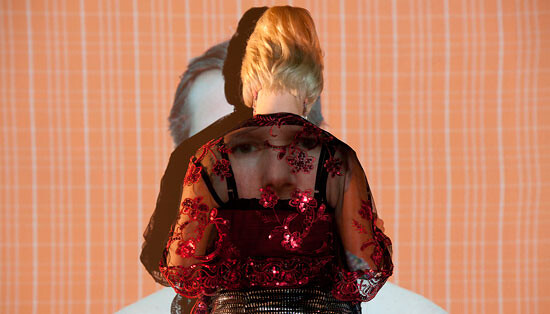

Desiring Assemblages / Queer Assemblages / Toxic Assemblages (voice 2)
According to Gilles Deleuze and Félix Guattari, a body is not an isolated entity, but involved in assemblages as well as being an assemblage itself, consisting of dynamic relations among objects, images, and concepts.7 The body without organs seems a particularly promising figure, since it consists of parts which are no longer organized in order to be functional for a whole. Those dis-organized parts escape categorization, hierarchization, and subjectivization, yet they still form a unity that affects and gets affected, a unity whose activity may change directions, and may grow or be reduced in intensity and speed. Deleuze/Guattari are not interested in drawing clear-cut borders between human, animal, technological, animated, or lifeless bodies, nor between imaginary bodies, body images, and flesh. Rather, they ask about processes of becoming. Dynamic relations form and transform particular assemblages; they may territorialize, that is, stabilize in a normative or idealized format, yet they may also deterritorialize, and they are celebrated when providing occasions for lines of flight.
From a queer perspective, I am attracted to the fact that in Deleuze/Guattari’s thinking, it is desire that conjoins assemblages and keeps them moving.8 Desire shows up as assemblage, while the assemblage is a desiring-machine (Deleuze/Guattari), or as Margit Shildrick puts it: Desire “comes into being through what Deleuze and Guattari call ‘desiring machines,’ assemblages that cannot be said to exist outside of their linkages and interconnection.”9 Accordingly, assemblages produce desire by connecting and moving. So what would it mean to combine reflections on toxicity with the dynamics of desire? Is there a specific affinity among desiring assemblages, queer assemblages, and toxic assemblages? Does the combination of toxicity’s capacity to affect bodies and desire’s capacity to connect bodies have the potential to capture and transform complex relations of power and domination?
Queer-feminist approaches that focus not primarily on gender and sexuality, but instead look at gender and sexuality’s heterogeneous connections with other dimensions of embodied subjectivity, point out that desire is simultaneously a conservative as well as a transformative force. It differentiates and creates hierarchies, yet it also disrupts normalized expectations and inspires unexpected connections.10 Furthermore, desire is seen as unfolding a constitutive force not only in subjectivities and intimate social relations, but in societies. Queer-feminist approaches link a Deleuzo-Guattarian notion of desire’s productivity being prior to power with an understanding influenced by Michel Foucault, which considers desire as a socio-historical product of power (or, more specifically, of power/knowledge systems).11 The two moments of desire as stabilizing and challenging relations of power are neither played against one another nor subordinated to a harmonizing synthesis.
With regard to the question of how the movements of desire are actualized, how desire produces connections, and how it is possible for these connections to become queer, Elspeth Probyn comes to the conclusion that desire moves in images, or that images “move as lines of desire.”12 Images bring a specific socio-historical imaginary into play. They materialize in bodies or show up as visual material. The movements of images make it possible to liberate desire from being bound to a subject or an object and thus also elude the hierarchical subject/object arrangement. Images traversing the “surface of the social” undermine the notion that the assemblage takes place between reified objects, signs, or bodies.13 Alternating ambiguously between notion and imagination, imprint and designed surface, images are both singular and concrete. Through attention to images, Probyn undermines readings that understand Deleuze/Guattari’s concept of desire as ahistorical, transcendent, or ontologizing. At the same time, she also emphasizes that representation cannot be constrained to the field of the regulated production of meaning or controlling power, but rather makes use of the linkage between imagination and desire to impel anticipative and transforming movements: “The image, thus freed from its post within a structure of law, lack, and signification, can begin to move all over the place. It then causes different ripples and affects, effects of desire and desirous affects.”14
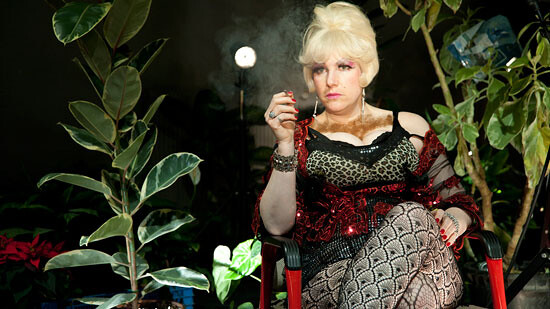

The imagery of Toxic and the accompanying considerations by Renate Lorenz and Pauline Boudry remind us that images are also loaded with violence. Thus, the connections and movements of desire may actualize themselves in a simultaneously intoxicated and intoxicating image. Toxicity also demands that we find our way back from the image to the body, since the toxic reveals the vulnerability of the body and its capacity for being affected. This image-poison-body assemblage needs to be addressed if we desire social transformation, and if art and politics aim at undermining hierarchies, exclusions, and normalizations. To “construct the possible,” as Probyn puts it, requires “images of bodies and desires, history and histories that are central to reformulating the social.”15 Yet, “the possible is only real with the addition of an act of mind that throws its image back into the past once it has been enacted.”16 Such desiring movements between past and present that invite the future as an immediate possibility characterize Toxic, as they do most of the previous films by Boudry/Lorenz. In inviting embodiments, which in “transtemporal drag” transgress clear-cut borders between past, future, and present, between image and body, between identification and desire, they provide a space for queer sociality.17
Queer sociality, as envisioned by Elizabeth Povinelli, is able to integrate histories of exploitation, domination, and violence into friendship practices fueled by joy, happiness, and respect.18 Acknowledging and acting upon conditions of irreducible difference, asymmetry, and power becomes possible due to an understanding of desire as carrying with it a simultaneity of pleasure and pain. Yet, while for Jacques Lacan jouissance is an antisocial experience, Povinelli insists that jouissance may be shared, and indeed may turn into queer sociality. Her conviction that embodied subjectivities and relationships—which carry sexist, racist, heteronormative, ableist, and colonial legacies—might be transformed, but not without conflict and injuries, develops from her friendship with an old indigenous woman named Ruby Yarrowin. Their friendship developed very slowly from a linguistic research process, which, in moments of joy again and again confronted both of them with the ongoing pain induced by the white hegemony of Australian settler colonialism. The asymmetric research setting, the striving for language and understanding, Yarrowin’s kinship relations in contrast to Povinelli’s lesbian self-understanding, created unbridgeable gaps. Facing these differences while acknowledging the limits of communication nevertheless created an intimacy of jouissance, joyful and painful at the same time. Looking at wider social practice that developed from the bonding built upon jouissance and, in fact, extending beyond Yarrowin’s death as a kinship community that incorporated Povinelli, she proposes the term “queer sociality.” If we now conjoin queer sociality and the toxic, we want to focus on the body as an assemblage, more precisely as a desiring assemblage, a model which challenges distinctions between bodies or between bodies and images in order to allow for a transformation of socialities.


Queer Socialities (voice 1)
Everybody in the team was sick when we were shooting Toxic at Aubervilliers in February 2012. The illness, whose cause was unknown, produced a strange but overwhelming union of us all through infection. We wondered if it was a virus (influenza or a stomach flu) or if it was in fact a substance, a toxic one. Could it have been a cure, if taken in a small dose? Yet, in higher concentrations as we experienced it, it produced a quite tough body-substance-object-connection. However, it allowed for escapes (staying in bed, alone or in company; being comforted by cushions; refusing to work; dreaming instead of functioning). At the same time, for some of our bodies it was too much to take. Thinking back to this collaborative illness, I ask myself if the body thinks differently and produces differently under such conditions. Did our bodies act on forms of collectivity in the course of the production? Or, the other way around, was our serious illness caused by the filming of Toxic? Was there a certain predisposition to feeling sick, since we were obsessed with toxic processes? My assumption is that toxicity is something different than a feature or a substance that can be isolated; rather, it occurs as part of a certain relationality.19
Mel Y. Chen echoes this argument when she argues that discourses of toxicity often produce or uphold social hierarchies and racist assumptions.20 One of her examples is toys produced in China for export and marked by Western media as toxic and dangerous to kids. Apart from the fact that this danger seems to target white, middle-class kids, the media coverage also ignores the toxic working conditions in China grounded in Western consumerism. For the matter of understanding the complex effects of toxicity, her text makes a couple of interesting twists and turns. Once the reader feels sure about comprehending her argument on the hierarchizing effect of discourses on toxicity, she unexpectedly shifts attention to her personal condition of “multiple chemical sensitivity.” She explains that she cannot leave the house without a mask, and when she’s outside she perpetually scans her surroundings:
Some passenger cars whiz by; instinctively my body retracts and my corporeal-sensory vocabulary starts to kick back in. A few pedestrians cross my path and before they come near, I quickly assess whether they are likely (might be the “kind of people”) to wear perfumes or colognes, or sunscreen. I scan their heads for smoke puffs or pursed lips prerelease; I scan their hands for a long white object, even a stub. In an instant, quicker than I thought anything could reach my liver and have it refuse, the liver screams hate, hate whose intensity each time shocks me.21
The reader becomes aware that Chen’s critical attitude towards discourses of toxicity does not help her in keeping her personal relation to toxicity and its harmful effects at arms length. Recognizing her intense hatred of those who might expose her to a toxin, she draws another unexpected connection: she is reminded of the hatred she experienced in others when they confronted her, the adolescent butch of Asian origin, with homophobic and racist comments. Obviously, the relationship between bodies and toxins cannot be explained by chemical reactions, but depends upon and affects the organization of the social. Chen, in addition, does not only see others as potential danger, but she is seen as dangerous herself; wearing a mask, she appears to others as a potential bearer of a virus, such as AIDS or SARS.
Following these considerations, I would like to rethink the connection between body and toxin. Instead of understanding it as an encounter of two entities (the body confronted with a substance that might be either healing or destructive), the body-toxin relationships come into view as an assemblage of elements. Fueled by power relations, the assemblage is flexible in its configuration, functions, and effects. Thus, not a toxic substance, not an intoxicated body, but becoming-toxic: an embodiment without differentiation between “taking poison” and “being poison,” a body configuration which cannot be understood by applying common categories. Ambivalences are not only allowed but facilitated: between poison and cure; between the drug, which is enjoyable and enables different body practices, and the substance, which intoxicates, paralyzes, or even kills.
In Queer Art, I suggested the term “drag” as name for this kind of assemblage.22Drag introduces yet another feature: it allows for ambivalences between bodies and images, or phantasies of embodiments. Drag is a hybrid between body and image, neither a document nor a fiction. The application of the term drag and the acknowledgement of its hybridity allow me to see Toxic as not intending to represent or document “deviant” bodies. There might be similarities to bodies, but it seems more accurate to talk about embodiments. These are always “other” (not “other than normal” but “beyond”), in “another time” and “elsewhere.” They are saturated not only with public fantasies but also with haunting images from the past. Thus, drag facilitates the production of a particular reference to the practices of shows, of freak shows, of male and female impersonators, of cakewalks, of epileptic dances, of cross-dressing: practices that drive and have driven gender, sexual, and anti-racist activism and which have tested out and reproduced strategies of estrangement and distancing from norms and normalcy.
As I suggest in Queer Art, drag as an artistic practice might break hegemonic interpellations, producing a temporal and spatial distance—a deferral and a gap—between an experience and its possible effects on the process of subjectivation. Thus, drag assemblages do not engage in “doing gender/sexuality/race,” but instead support an “undoing.” If, as Judith Butler writes, I am constituted through norms that are not of my own making, then drag helps to understand how this constitution occurs.23 Furthermore, it reconstructs it on one’s own body. But at the same time, drag is a way to organize a set of effective, laborious, partially friendly, and partially aggressive methods of producing distance to these norms—for instance, to the two-gender system, to being-white, being-able, and to heteronormativity. In its (un)doing capacity, drag proposes images in which the future can be lived. Drag, then, is fabricated by sets of bodily characteristics and actions. While it may indeed depict norms, it is by no means subjected to them.
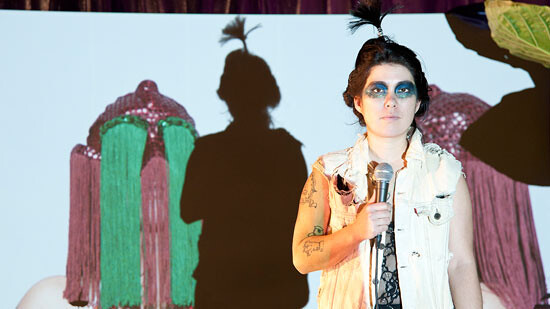

Becoming-indigestible: The Intoxication of Projective Integration (voice 2)
While drag undermines the norm, experiences of inequality and hierarchization still need to be considered in relation to processes of normalization that integrate rather than exclude. Normalization may appear as, for example, addressing “difference as cultural capital” in neoliberal consumer culture, or through appropriating the former “other” as an indicator of a tolerance built upon a subtle hierarchy between who tolerates and those tolerated. Thus, one may also ask whether the ec/static bodies and queer connections that Toxic displays, and which have been honored here as the “dirty and uncanny by-products” of the media apparatus, are by now an integral part of a socially acknowledged “possible.” I coined the term “projective integration” in order to point out the inherent role of images and their projection onto social bodies for such processes of neoliberal modernization.24 Images employed in these processes function as projections of today’s contradictory character of difference: on the one hand, difference perceived as cultural capital, providing promising features to the individual, and on the other hand, difference that carries with it the threat of stigma and devaluation. Projective integration strives to activate the individual by stimulating the desire to manage skillfully the precariousness of difference. The individual challenge consists in developing a sovereign mode of embodying precariousness. On a social level, projective integration is a form of biopolitical management that imposes on the individual the responsibility for failure, success, and thus social inequalities and hierarchies, while simultaneously securing the hegemony of a neoliberal achievement principle and market logic.
So, if one longs for recognition and the inclusion of differences and singularities, but does not believe in or agree to being subsumed within neoliberal pluralism, how can one resist? What are the options of queer cultural politics and artistic practices? In addition to the considerations on drag, I would like to introduce the notion of becoming-indigestible. This notion underlines the paradoxical moment of being incorporated, yet not built into the system. It refers to the idea of toxicity, since it implies remaining non-assimilable. I would like to consider whether it might prove useful as a critique and reworking of social processes of projective integration. The toxic—resisting being digested and split up into useful parts that can be integrated into the system—turns out to be a means of either changing or, maybe, destroying the system from within. Even if it finally gets discarded, the toxic can have effects on its host that are threatening, even life-threatening, or pleasurable. Following Chen, I would like to ask about queer productivity and queer socialities, even in “queer-inanimate social lives,” that “toxicity propels, not repels … inviting loss and its ‘losers.’”25
I understand becoming-indigestible not simply as a queer political strategy against processes of projective integration, but in favor of a “move beyond the painful ‘antisocial’ effects to consider the sociality that is present there … the queer-inanimate social lives that exist beyond the fetish, beyond the animate, beyond the pure clash of human sex.”26 And note, it is becoming, not being, indigestible. Becoming, according to Deleuze/Guattari, is not a temporal process; it refers neither to a linear development from A to B nor to the continuity of development. As they write in What is Philosophy?, becoming is
not the transformation of one into the other … but something passing from one to the other … It is a zone of indetermination, of indiscernibility, as if things, beasts, and persons … endlessly reach that point that immediately precedes their natural differentiation.27
Thus, transtemporal drag comes back to mind, with its claim of indiscernibility between future, past, and present, as well as its perpetual suspension of the question regarding the artificial naturalness or natural artificiality of bodies and images: “becoming is neither an imitation nor an experienced sympathy, nor even an imaginary identification.”28 Becoming-indigestible, therefore, does not reveal anything about the subject or object of digestion, but implies “something passing” that, in fleeing established forms of subjectivity and sociality, forms queer, toxic-desiring assemblages. This might be what Chen experiences in the intimacy with her sofa, which in moments of hypersensitivity provides, as she describes, for an animated interobjectivity between the sofa’s mammal skin and Chen’s own, as well as for a different perception of her lover, whom she conflates with the sofa.29
Returning to Toxic, I would like to ask whether becoming-indigestible might also prove useful for conceiving artistic strategies that aim to challenge intoxication by cultural images or social relations. As Toxic proposes, subjectivities developing from processes of intoxication may decide to function as toxic themselves rather than seeking detoxification. This is a double-edged attempt, since it steps into a tradition of declaring those who have been exposed to intoxication toxic themselves and treating them accordingly. Toxic plays out this reversal, or shall we call it perversion, ironically. The people wearing masks in the mug shots experience an amplification of their presumed monstrosity, while they are simultaneously protected by the masks and seem to wear them proudly or even as protest signs; or rather, it is not a wearing of masks, it is practicing drag. There is an ambivalence between sympathy and threat: “Sometimes a mask is still a mask, even if it is simultaneously a masquerade.”30 Played out as desiring assemblages between the images on the screen, the figures in drag, the potted plants, and the production crew resembling and sacrificing the apparatus, power and violence are embodied and incorporated, but not digested. The historical format of the mug shot remains visible. Thanks to a vivid cough, intoxicating substances spread all over the place. The glittering whirl gets stuck in the vacuum cleaner rather than being sucked in. Thus, one could say that Toxic becomes-indigestible—a site of queer sociality among those “who celebrate existence outside the charmed circle of sexual normativity”—because it does not dissolve or neutralize the toxicity of the media apparatus, but embodies its connection to jouissance, indiscernibly pleasurable and painful.31
(2012) by Pauline Boudry and Renate Lorenz, film installation, vitrine with fifteen photographs, curtain, theatre spots, Super 16mm, 13 minutes. Director of photography: Bernadette Paassen. Performers: Werner Hirsch, Ginger Brooks Takahashi.
Yvonne Rainer, Inner Appearences, 1972; Mierle Laderman Ukeles, 1979–80.
Kerstin Brandes, Fotografie und “Identität”. Visuelle Repräsentationspolitiken in künstlerischen Arbeiten der 1980er und 1990er Jahre (Bielefeld: transcript, 2010).
Today’s digital technology depends on toxic substances and working conditions in the production of cameras and computers.
Shawn Michelle Smith, Photography on the Color Line: W.E.B. Du Bois, Race, and Visual Culture (Durham and London: Duke University Press, 2004), 90.
Sara Ahmed, Strange Encounters: Embodied Others in Post-Coloniality (Routledge: London, New York 2000).
Gilles Deleuze and Félix Guattari, A Thousand Plateaus: Capitalism and Schizophrenia 2 (1980), trans. Brian Massumi (Minneapolis: University of Minnesota Press, 1987).
Ibid.; Gilles Deleuze, Desire and Pleasure (1977), trans. Melissa McMahon. For queer theoretical approaches, see Elspeth Probyn, Outside Belongings (London: Routledge, 1996); Elizabeth Grosz, “Refiguring Lesbian Desire,” Laura Doan (ed.), The Lesbian Postmodern(New York: NYU Press, 1994), 67–84; Chrysanthi Nigianni, Merl Storr (eds.), Deleuze and Queer Theory (Edinburgh: Edinburgh Univ. Press, 2009).
Margrit Shildrick, “Prosthetic Performativity: Deleuzian Connections and Queer Corporealities,” in Chrysanthi Nigianni and Merl Storr (eds.), ibid., 115–33, here 124.
Probyn, ibid., 43; Antke Engel, “Desire for/within Economic Transformation,” e-flux journal 17 (June 2010). See →.
Cf. Deleuze, Desire and Pleasure, ibid.; Michel Foucault, The History of Sexuality Vol. 1 (1976), trans. Robert Hurley (New York: Vintage, 1980); Probyn, ibid., 48.
Probyn, ibid., 59.
Ibid., 13.
Ibid., 59.
Ibid., 117.
Gilles Deleuze, Michel Foucault: Philosophe (Paris: Seuil,1989), 17; quoted in Probyn, ibid., 117.
Pauline Boudry and Renate Lorenz, Temporal Drag (Ostfildern: Hatje Cantz, 2011);
Elizabeth Povinelli, “The Part That Has No Part: Enjoyment, Law, and Loss,” GLQ: A Journal of Lesbian and Gay Studies Vol. 17, No. 2–3 (2011): 287–308.
Karen Barad describes a microorganism, a dinoflaggelate called Pfiesteria piscicida, which is neither plant nor animal, but able to change its nature according to the conditions of its environment. This microorganism, which is also called “killer dinoflagellate,” is responsible for a mass killing of over a billion fish. It is highly toxic for fish but, interestingly, this feature can only be proved in the presence of fish. Without being in contact with fish, no toxic nature or substance can be found. Cf. Karen Barad, “Nature’s Queer Performativity,” Qui Parle Vol. 19, No. 2 (2001): 133ff.
Mel Y. Chen, “Toxic Animacies, Inanimate Affections,” GLQ: A Journal of Lesbian and Gay Studies Vol. 17, No. 2–3 (2011): 265–286.
Chen, ibid., 274f.
Renate Lorenz, Queer Art: A Freak Theory (Bielefeld: Transcript Verlag, 2012).
Judith Butler, Undoing Gender (New York: Routledge, 2004).
Antke Engel, “The Surplus of Paradoxes: Queer/ing Images of Sexuality and Economy,” in Celine-Marie Pascale (ed.), Social Inequalities & The Politics of Representation: A Global Landscape (London: Sage, 2013), 176–188.
Chen, ibid., 281.
Ibid., 282.
Gilles Deleuze and Félix Guattari, What Is Philosophy?, trans. Bernd Schwibs and Joseph Vogl (New York: Columbia Univ. Press, 1994), 173.
Ibid.
Ibid., 278.
Chen, ibid., 279.
Povinelli, ibid., 302.